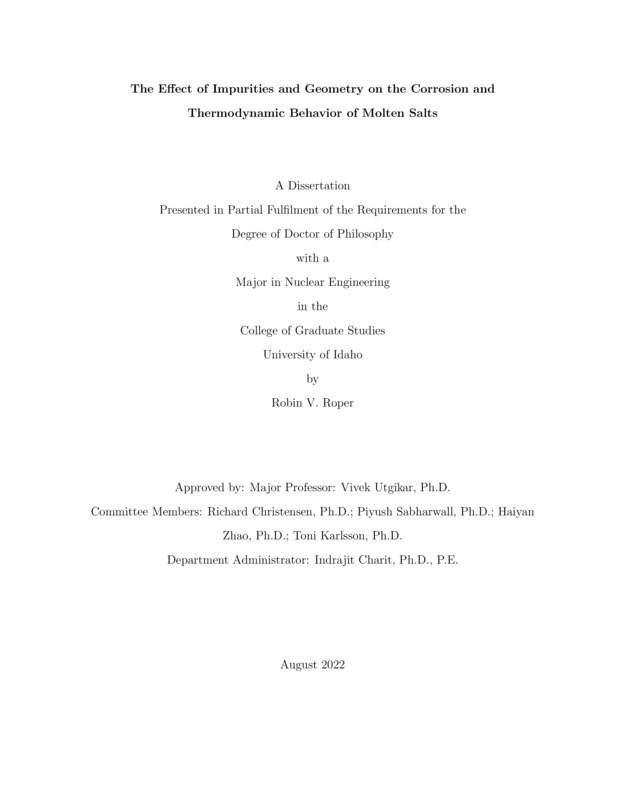The Effect of Impurities and Geometry on the Corrosion and Thermodynamic Behavior of Molten Salts
Roper, Robin Virginia. (2022-08). The Effect of Impurities and Geometry on the Corrosion and Thermodynamic Behavior of Molten Salts. Theses and Dissertations Collection, University of Idaho Library Digital Collections. https://www.lib.uidaho.edu/digital/etd/items/roper_idaho_0089e_12455.html
- Title:
- The Effect of Impurities and Geometry on the Corrosion and Thermodynamic Behavior of Molten Salts
- Author:
- Roper, Robin Virginia
- ORCID:
- 0000-0002-8848-928X
- Date:
- 2022-08
- Keywords:
- COMSOL Corrosion Impurity Melting Molten Salt
- Program:
- Nuclear Engr & Industrial Mgmt
- Subject Category:
- Nuclear engineering; Chemical engineering; Nuclear chemistry
- Abstract:
-
Molten salt systems are highly relevant to the energy industry and have become a focus of much research in recent years, particularly in nuclear energy and thermal energy storage. Many types of molten salt are used for various systems, including fluoride, chloride, and nitrate salts. These types of salts have thermodynamic and chemical properties, which make them advantageous to energy production systems. Molten salt systems are superior to other systems in many ways, including design simplification, atmospheric operating pressures, higher heat capacities, safer operational parameters, and the possibility for on-line salt processing. Despite the advantages of a molten salt system, these concepts can also contain more complexity than many other energy storage systems due to the chemistry of the salt mixtures. In particular, molten salt systems can be particularly susceptible to corrosion. A risk assessment was performed as part of this dissertation, determining that corrosion risk is of particular concern in designing a molten salt system.
To address the risk of corrosion in molten salt system design, two phases of research were conducted, which are described in this work. The first phase aimed to determine the effect of corrosion on the thermodynamic behavior of molten salt. In particular, the melting behavior of two types of molten salt was investigated, with additions of impurities that could result from corrosion. The second phase of research aimed to determine the effect of system design on molten salt corrosion. By use of COMSOL multiphysics, four different basic geometries were modeled, which were representative of geometries that could be found in a large-scale system. Molten salt laminar flow was modeled in these geometries, with corrosion behavior coupled to the laminar flow physics. This model was first of its nature and thus was simple in form. It provided information on the general impact of design changes on the velocity profile and corrosion behavior in representative geometries.
The combination of experimentation and modeling determined that design changes can be made to reduce the impact of corrosion on a molten salt system. Extending the system temperature to above the entire melting range of a molten salt will ensure an operating fluid that is entirely liquid in phase. Modifying geometry to reduce areas of peak velocity will reduce the intensity of local corrosion, and reducing the overall system velocity will also reduce corrosion. Incorporating system design changes such as these in preliminary phases of design can reduce overall corrosion risk, extending the lifetime of the system.
- Description:
- doctoral, Ph.D., Nuclear Engr & Industrial Mgmt -- University of Idaho - College of Graduate Studies, 2022-08
- Major Professor:
- Utgikar, Vivek
- Committee:
- Christensen, Richard; Sabharwall, Piyush; Zhao, Haiyan; Karlsson, Toni; Charit, Indrajit
- Defense Date:
- 2022-08
- Identifier:
- Roper_idaho_0089E_12455
- Type:
- Text
- Format Original:
- Format:
- application/pdf
- Rights:
- In Copyright - Educational Use Permitted. For more information, please contact University of Idaho Library Special Collections and Archives Department at libspec@uidaho.edu.
- Standardized Rights:
- http://rightsstatements.org/vocab/InC-EDU/1.0/

